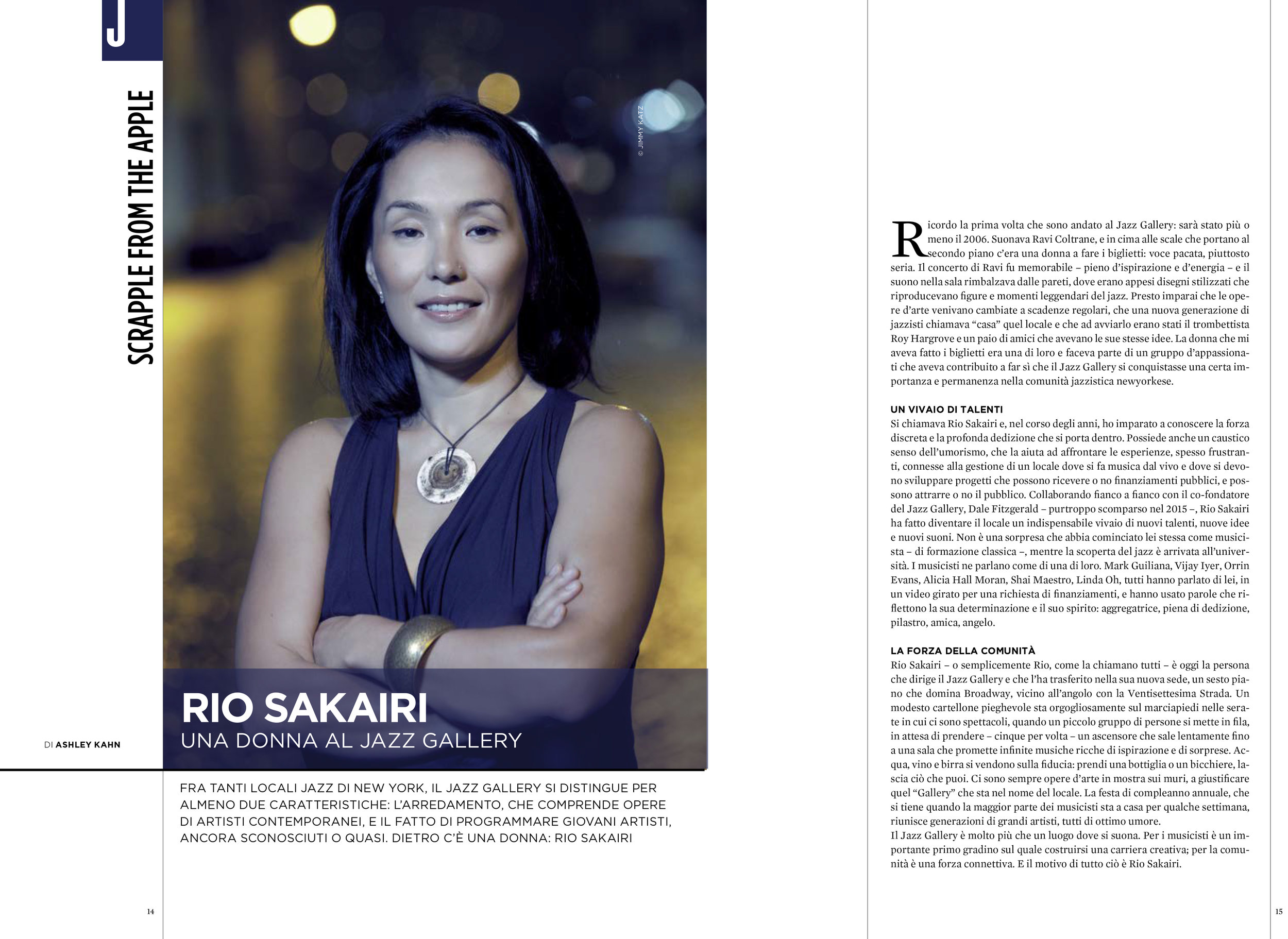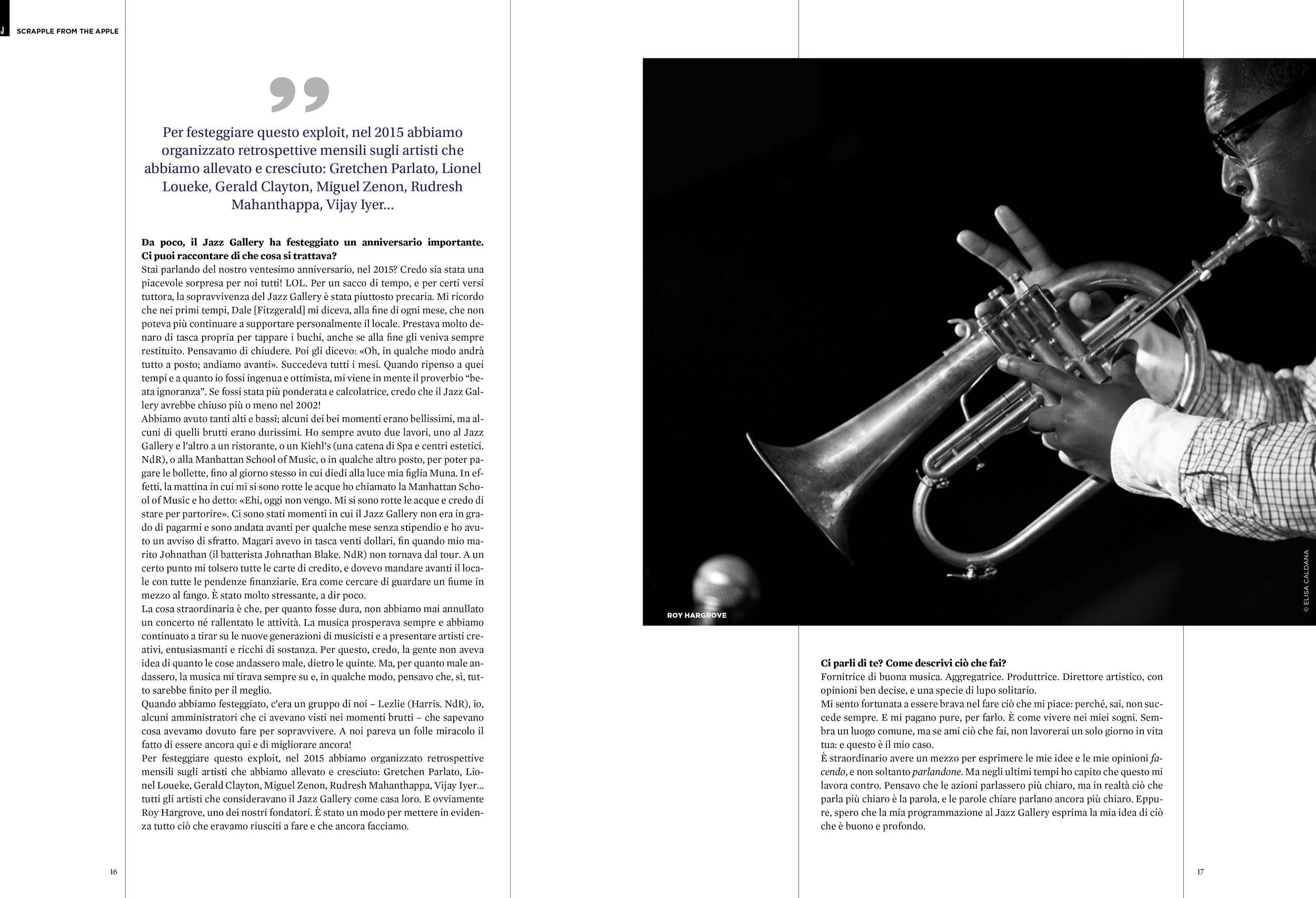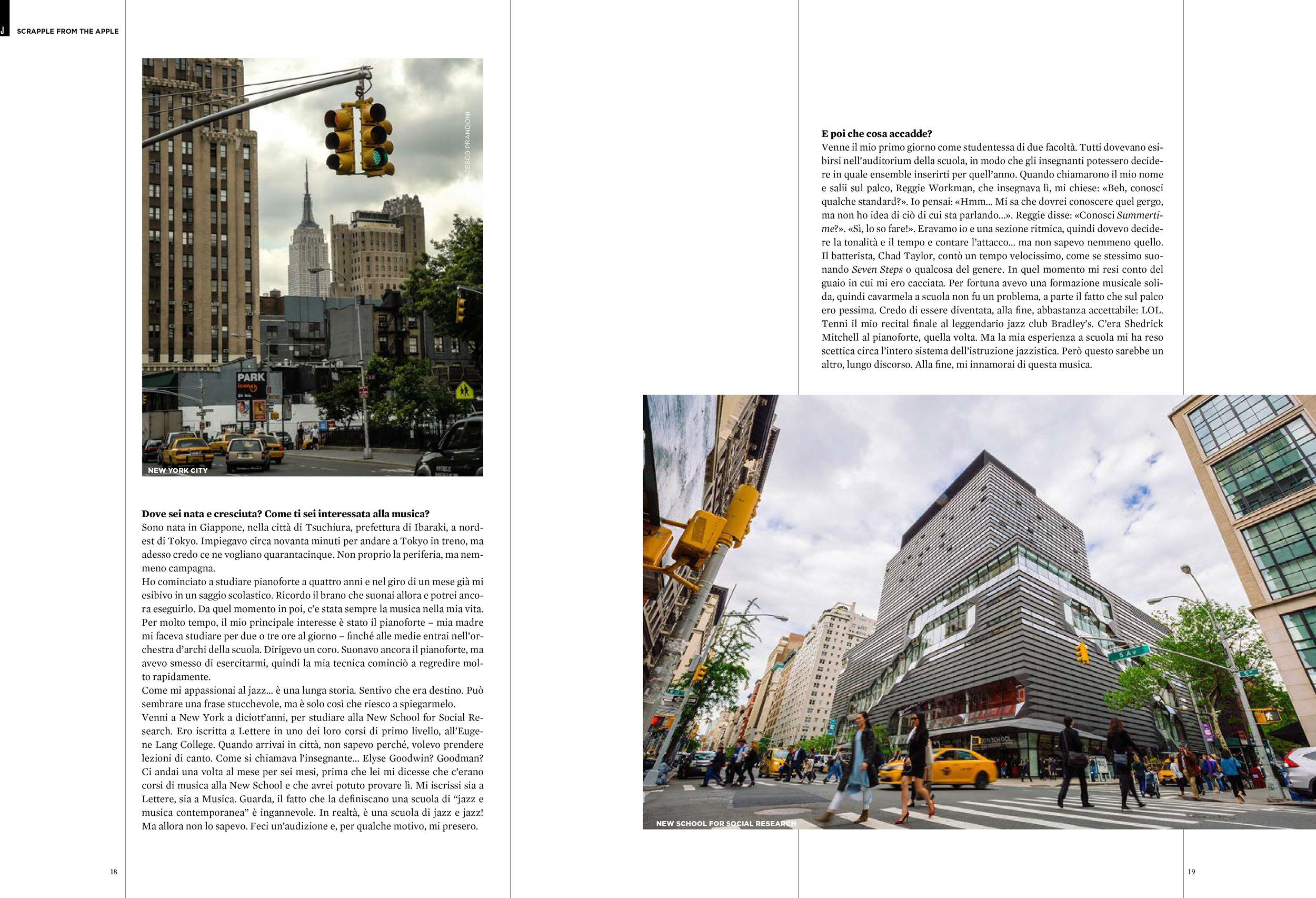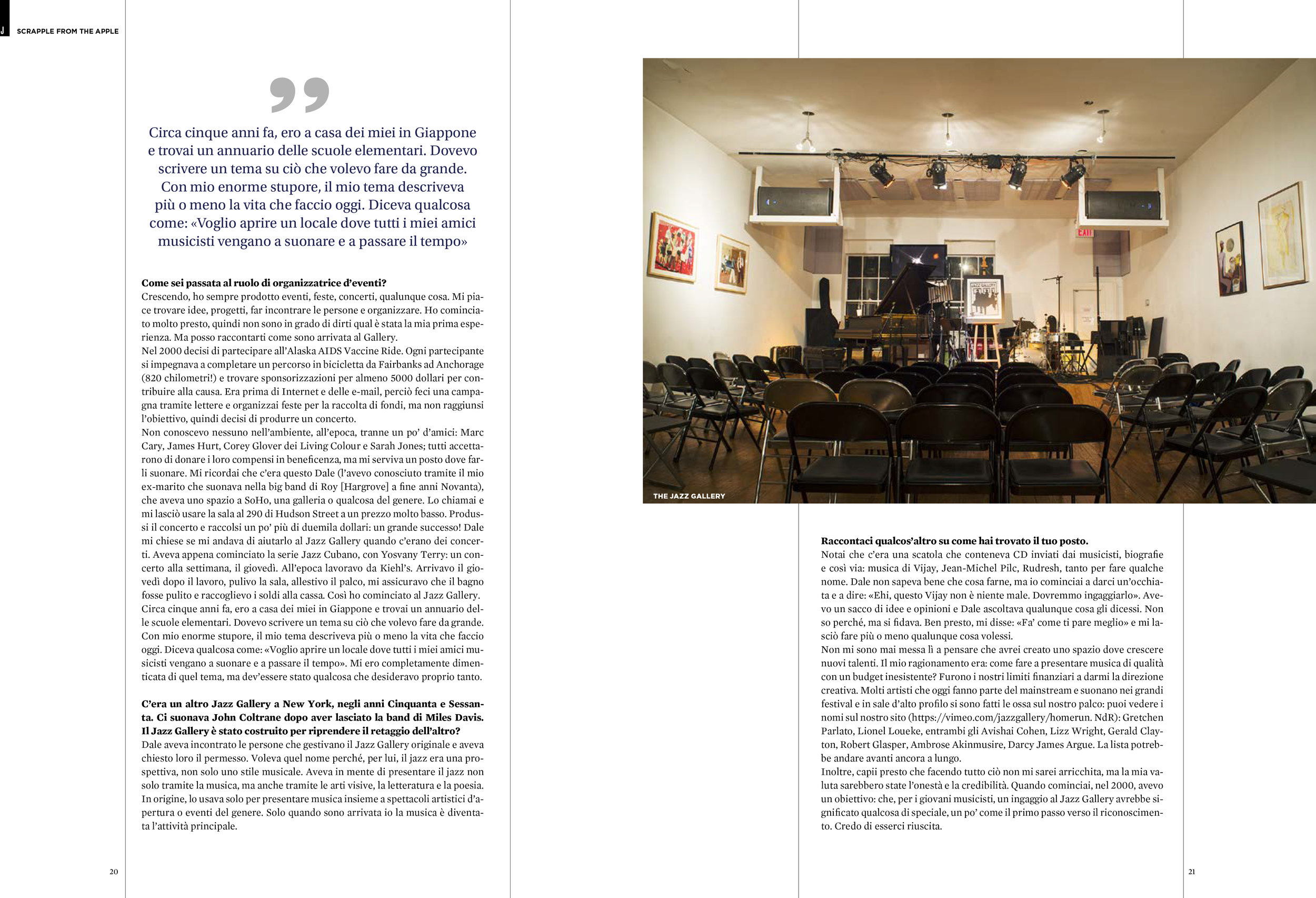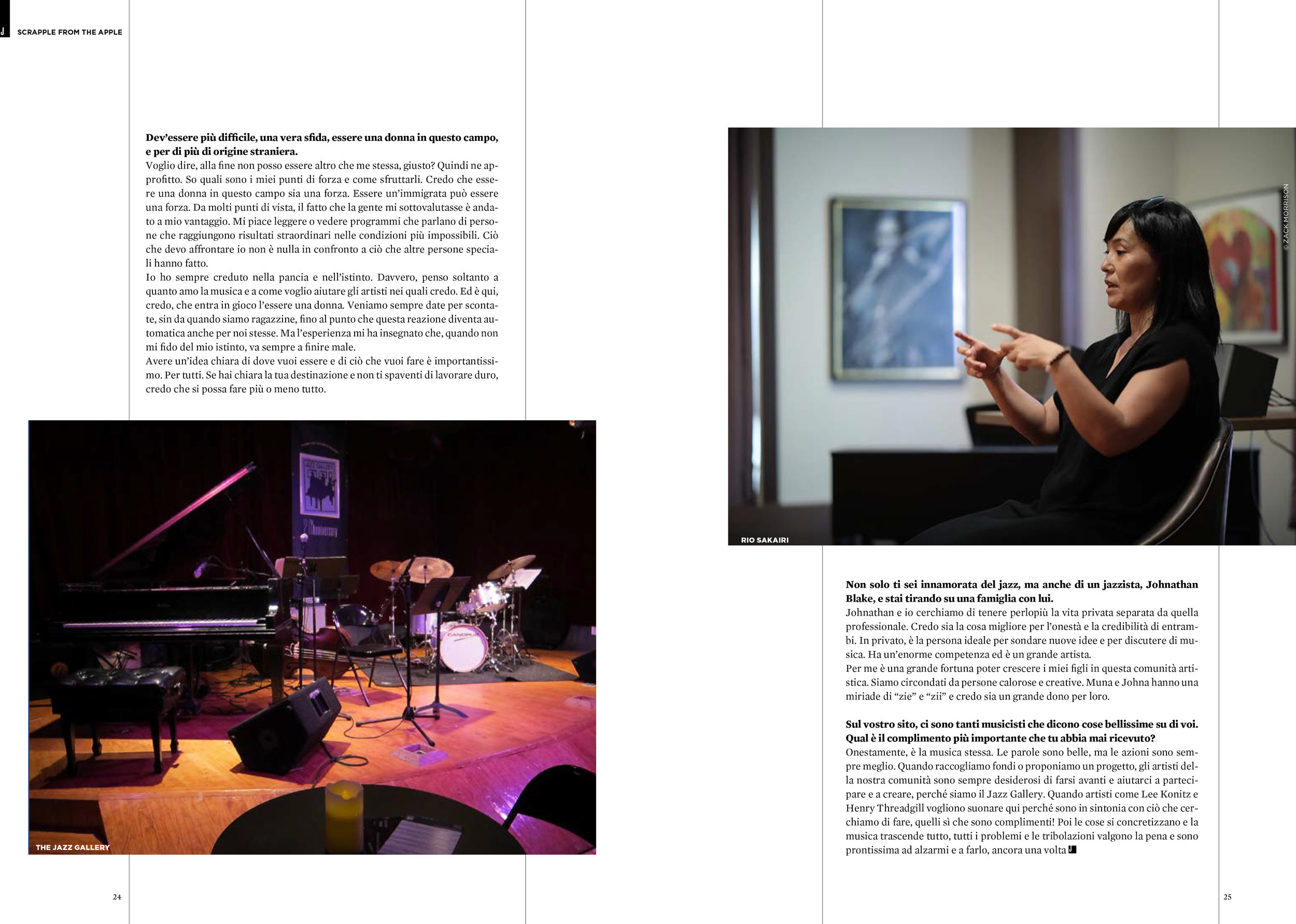I have often been asked, “How did you get a job as an Artistic Director?” Well, I didn’t get a job as the Artistic Director of The Jazz Gallery. Dale Fitzgerald has given me an opportunity to build the place from ground up. Eventually, The Jazz Gallery has grown to the point where I needed an official title to the outside world and “Artistic Director” seemed befitting considering that I have been setting the creative directions for The Jazz Gallery for the past two decades.
Ashley Kahn has interviewed me a while back for the JAZZIT magazine and I talked a lot about how I got started in life, in music, and at The Jazz Gallery. Here is an original interview in English.
_____________
Not long ago, The Jazz Gallery celebrated an important anniversary. Can you describe what it was about?
Do you mean our 20th Anniversary back in 2015? I think we were all pleasantly surprised! LOL . For such a long time, and it continues to be this way to some extent, the survival of The Jazz Gallery has been quite precarious. I remember the early days at The Gallery, Dale [Fitzgerald, founder of The Jazz Gallery] would say to me at the end of each month that he can no longer continue to personally support the venue. He was lending a lot of his money to fill the holes, which was all paid back eventually. But we did consider closing it down. Then I would say to him, “Oh it will somehow be okay; let’s keep it going.” This went on every month. When I look back at that time and think of how optimistic and naive I was, I think of the phrase “Ignorance is bliss.” If I were more thoughtful and calculated in any way, I think The Jazz Gallery would have closed down around 2002!
We went through so many ups and downs; some highlights were so great but some of the tough times were so hard. I always had two jobs, one at The Gallery and another at a restaurant or a Kiehl’s or the Manhattan School of Music [MSM] or wherever, to pay my own bills, up until the day before I gave birth to my daughter Muna. I actually called MSM on the morning when my water broke saying, “Hey. I’m not coming in today. My water broke and I think I’m giving birth.” There were times that The Gallery couldn’t pay me and I went a few months without pay. I would have $20.00 in my wallet until my husband [drummer] Johnathan [Blake] came back from his tour. All of my credit cards were canceled at one point, and then trying to keep the venue going with its own deficits. It was all like wading through the mud. It was really stressful to say the least.
The amazing thing is with all the hardship, we have never canceled a show nor slowed down our activities. Music was always thriving and we continued raising the next generation of musicians and presenting artists who were creative and exciting and with substance. I think because of that, people had no idea how bad things were behind the scene. Also, as bad as things were, music always lifted me up and somehow I thought, yes, it will all be totally fine.
When we celebrated the 20th Anniversary, there were handful of us - co-founder Lezlie Harrison, me, a few board members who saw us through the rough time - who knew what we had to do to survive. For us, it felt like some crazy miracle that we are still here and we were doing better!
To celebrate this remarkable feat, in 2015 we presented monthly retrospectives of the artists whom we nurtured and raised: Gretchen Parlato, Lionel Loueke, Gerald Clayton, Miguel Zenon, Rudresh Mahanthappa, Vijay Iyer—every artist who considered The Jazz Gallery their home. And of course Roy Hargrove one of our original founders. It really highlighted all that we had accomplished and what we continue to do.
Can you tell us about yourself? How do you define what you do
Purveyor of good music. Community builder. Nurturer. Producer. Strongly opinionated Artistic Director and somewhat of a lone wolf.
I feel fortunate that I’m very good at what I like doing because that’s not always the case, you know? And I get paid doing that? I’m totally living my dream. It’s such a cliche but when you love what you do, you don’t work a day in your life and that is me.
I think it’s amazing that I have a platform where I can express my ideas and opinions by doing and not just talking about it. But recently, I realized that that is working against me. I thought action speaks louder but in reality, speaking speaks louder and speaking louder speaks even louder. Even so, I hope my programming at The Jazz Gallery expresses my idea of what’s good and soulful.
Where were you were born and raised, and what got you into music in the first place?
I was born in Tsuchiura city in Japan’s Ibaraki prefecture, which is located North East of Tokyo. It used to take about 90 minutes by train to get to Tokyo but I think it only takes about 45 minutes now. Not quite the suburbs but not country, either.
I started learning piano when I was 4 and was playing in a group recital in a matter of one month. I still remember and can play the song I played then. Since then, I always had music in my life. Piano was my thing for a long time—my mother used to make me practice 2 -3 hours per day—until I started junior high school when I was in school string orchestra. I conducted a choir. I still played the piano but I stopped practicing so my skills on the instrument declined very quickly.
How I got into jazz—it’s a long story. It felt like it was meant to be. It sounds corny but I think that is the only way that makes sense to me.
I came to NYC when I was 18 to attend the New School for Social Research. I was a liberal arts major in one of their undergrad schools, Eugene Lang College. When I arrived in the city, I really didn’t know why but I wanted to take a voice lesson. What was the lady’s name—Elyse Goodwin? Goodman? I saw her every week for six months before she mentioned that the New School has a music division and I should try it out. I became a major in both Liberal Arts and Music. See, it’s really deceiving that they call the school for “Jazz and Contemporary Music.” In reality, it is a Jazz and Jazz school! But I didn’t know that. So I auditioned and for whatever reasons, I got in.
My first day as a double major came. Everyone had to perform in the school auditorium so the teachers could decide which ensemble you should be in for that year. When my name was called and I got on the stage, Reggie Workman [who is an instructor at the New School] said to me, “So, do you know a standard?” I thought, “Hmmmm. That lingo sounds like something I should know but I have no idea what that means…. ” Reggie said, “Do you know ‘Summertime’?” “Yes, I can do that!” It was me and a rhythm section so I had to call the key, tempo, and count the tune off—but I didn’t know even that. The drummer Chad Taylor counted off a really fast tempo like we were playing “Seven Steps…” or something. At the moment I realized the severity of the situation. Luckily, I had very strong musical training so getting through the school presented no issues, except that I was a terrible performer. I think I became kind of ok, eventually, LOL. I did my senior recital at the fabled jazz club Bradley’s. Shedrick Mitchell was on piano for that. But going through the school experience makes me skeptical of the whole jazz education thing. But that’s another long discussion.
In the end, I ended up falling in love with this music.
So how did you shift into doing event production?
Growing up, I was always producing events, parties, concerts, and whatever. I love coming up with ideas, planning, getting people together, and organizing. This started really early on so I can’t really tell you about my first experience. But I can tell you how I got to be at The Gallery.
In 2000, I decided to participate in the Alaska AIDS Vaccine Ride. Each participant made a commitment to complete a bike ride from Fairbanks to Anchorage (510 miles!) and get sponsored for minimum of $5000 to contribute to the cause. This was before the internet and emails so I did a letter-writing campaign and hosted fund-raising parties but did not reach the goal, so I decided to produce a fund-raising concert.
I really didn’t know anyone in the music business at that time except for a few friends—Marc Cary, James Hurt, Corey Glover from Living Colour, and Sarah Jones all agreed to donate their performances but I needed a venue. I remembered there was this guy Dale whom I met through my ex-husband who used to play in Roy [Hargrove]’s big band in late 90s, who had a space in SoHo, some gallery or whatever. I called him and he let me use the 290 Hudson really cheap. I produced the concert and it raised a little over $2K and was a great success!!
Dale then asked me if I want to help him around The Gallery when they had performances. He has just started the Jazz Cubano series with [saxophonist] Yosvany Terry — one show a week on Thursdays. I was working at Kiehl’s then. I’d come in on Thursdays after work and clean the space, set up the stage, make sure the bathroom was clean, and take money at the door. That’s how I started at The Jazz Gallery.
About five years ago, I was visiting my parents in Japan and I found a yearbook from elementary school. I had to write an essay about what I wanted to do when I grew up. My essay, to my astonishment, pretty much describes the life I have right now. It said something like, “I want to open a coffee shop where all my friends who are musicians come to play and hang out.” I completely forgot about that essay but it must have been something I really, really wanted.
There was another Jazz Gallery back in the ‘50s and ‘60s in New York City. John Coltrane played there after he left Miles Davis’s band. Is this Jazz Gallery built on the legacy of the other?
Dale actually met the guys who had the original Jazz Gallery and asked for permission from them. He wanted that name because to him, jazz is a perspective, not just a style of music. He had the idea of presenting jazz through not only music but visual arts, literature, and poetry. Originally he used to only present music in conjunction with art show openings and events like that. It was not until I got there that music became more of the focus.
Tell us more about how you found your place there.
I noticed that there was a box with submission CDs and bios and what-not, music from Vijay, Jean-Michel Pilc, Rudresh, just to name a few. Dale wasn’t doing much with it so I started checking out these packages and I would say, “Hey, this Vijay guy sounds kinda good. We should book him.” I had loads of opinion and ideas and Dale was open to whatever I had to say. For some reason, he trusted me. Soon enough, he said, “Do what you think is good” and let me do pretty much whatever.
I never started out thinking I’m going to create a space to nurture young musicians. My thought process was how can we present quality music with this non-existent budget. So our financial limitations gave me the creative direction. Many cats who are now mainstays at big festivals and high-profile venues cut their teeth on our stage—you can see the names on our website: Gretchen Parlato, Lionel Loueke, both Avishai Cohens, Lizz Wright, Gerald Clayton, Robert Glasper, Ambrose Akinmusire, Darcy James Argue. The list goes on and on.
I also quickly realized that I might not get rich doing this but my currency could be integrity and credibility and trust and respect. When I started in 2000, I had a goal: that, for young cats, getting a gig at The Gallery would mean something special—like their first step to being recognized. I think we achieved that goal.
Do you have any mentors or someone you look up to in the music business?
I have no role model per se. I feel like I waded into the water and learned my own way through trials and errors. A lot of errors. LOL. Though working for Kiehl’s while it was still family-owned company, I learned about customer service and some important ideas about creating loyalty. But I had no experience in music business before The Jazz Gallery so I was lucky to be able to make mistakes and learn from them. It’s like The Jazz Gallery and I grew up together. I was also very lucky that I had Dale as a partner. He had a big heart and for whatever reasons, he trusted me to do the right thing.
What’s your your programming philosophy at The Jazz Gallery?
It’s not about the booking but I have a very strong views about customer service. It’s super important to me that our customers are greeted with smiles and treated with kindness and respect. That goes for our artists and for audience members. We are nothing without the artists. Without them we are just a space. We are not able to pay what they deserve to be paid but we can offer a creative freedom and courtesy and good sound and smile. I tell my “kids”—the staff at The Gallery who I feel are my kids—not to take it lightly that people paid to be here and that their experience in The Gallery should be as welcoming and as comfortable as we can make it. We only have music. We don’t have comfortable chairs. Our air conditioning is often not so great. We are not a restaurant nor a bar.
Since 2012, The Jazz Gallery has been in its newer location in the Flat Iron area [1160 Broadway, near 27th Street]. Is this new neighborhood very different from where you used to be in the West Village?
They call this area NoMad now, LOL. I think it’s more convenient for people to get here—that’s about it. I realized over the years that sadly there is no loyalty to venues. Audience are loyal to the artists. In that sense, it’s as good and bad as before.
Moving was difficult, to put it mildly. Our House Manager at that time, Russell Moore, worked so hard to resolve issues at the new space as they came up. He was such a hero. There was a huge turnover in our already very small staff around the same time. Dale, who had retired, came back temporarily. I was doing everything. Then Janet Luhrs got on board as our executive director and, Oh my god, that was a relief and nerve wrecking at the same time.
Janet doesn’t know much about jazz but has a very very strong background in nonprofit management. With her financial acumen, we have raised enough money to be a solo occupant of the space, and then raised funds to really spruce up the space, sonically and cosmetically. 1160 Broadway has begun to feel like home this past year or so.
How does The Jazz Gallery fit into the NYC scene now—how is it different from other clubs and venues?
I think the way we run things is nimble and we take more risks artistically, partly because we run as nonprofit. We have positioned ourselves in a way that we are not influenced by whatever is happening in rest of the jazz scene. Rather, I think we lead by our programming.
For example, [pianist/composer] Kris Davis is hot right now. We commissioned her back in 2011 when a majority of jazz people didn’t know who she was. I heard her as a side person with other groups and heard something special so we got to know her, built a relationship, gave her gigs, and that led to us giving her commissions. Her first performances were poorly attended, but the music was amazing and it gave her an opportunity to create. It’s important to me that our support of artists are not one-offs. This is why I’m super careful when I take on a new artist.
It warms my heart when artists say, “I love playing at The Gallery because they don’t tell me what to play and how to play. I love the artistic freedom.” I think artists we work with really feel the love and respect and that is very important to me.
You’ve witnessed a lot since you started. Are things very different now?
It seems that no venues were putting support behind emerging artists like the The Jazz Gallery was doing in early 2000 but it seems like it’s a thing now. That’s good. And jazz being taught in schools is really affecting the music itself. I don’t know if that is all positive.
Also, NYC goes to bed much earlier now. I used to waitress at the club Visiones around 1991 when [bassist] Kiyoshi Kitagawa waited tables at a Japanese restaurant two doors down. I would go to Bradley’s after the shift there for their 02:00 set. Everyone would be there. I miss that.
Things must be different — and more challenging—being a woman in this the business, and originally from overseas.
I mean, ultimately I can only be me, right? So I take advantage of that. I know my strengths and play to them. I think being a woman in this business can be a strength. Being an immigrant can be a strength. In many ways, it’s been to my advantage that people underestimate me. I love reading or watching about people achieving amazing things under the shittiest conditions. What I’m dealing with is nothing compare to what other amazing people are doing.
I have always been about gut feeling and instinct. I really only think about how much I love music and how I want to support the artists I believe in. That’s where being a women comes in, I guess. We are constantly second-guessed since the time we are little girls to the point that that becomes your own reaction to yourself. But I have learned from the experience that doubting my instinct never ends well.
Having a clear picture of where you want to be and what you want to do is really important. For anyone. If your destination is clear and you are not scared of hard work, I think pretty much anything is doable.
Your website includes so many musicians who have great things to say about you. What’s the most meaningful compliment you ever received?
Honestly, the music itself. Words are great but actions are always better. When we do fundraiser of any kind or propose a project , the artists in our community are always willing to step up and help and participate and create, because it’s The Jazz Gallery. When artists like Lee Konitz and Henry Threadgill want to perform here because they resonate with what we are trying to do. What compliments those are! Then when everything comes together and the music transcends everything, all the troubles and tribulations are totally worth it and I’m totally ready to get up and do it, again.
